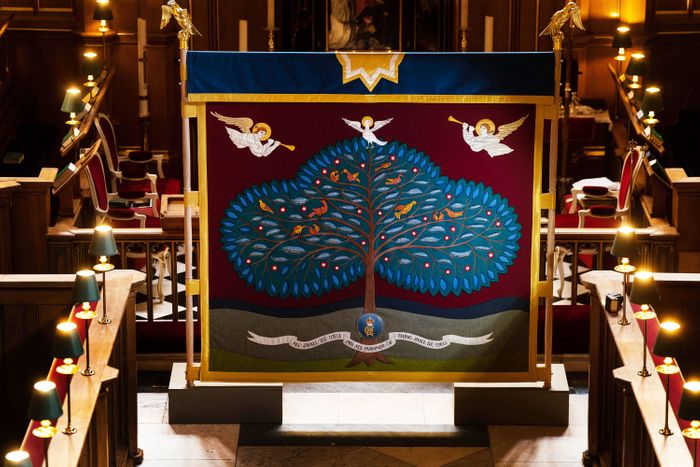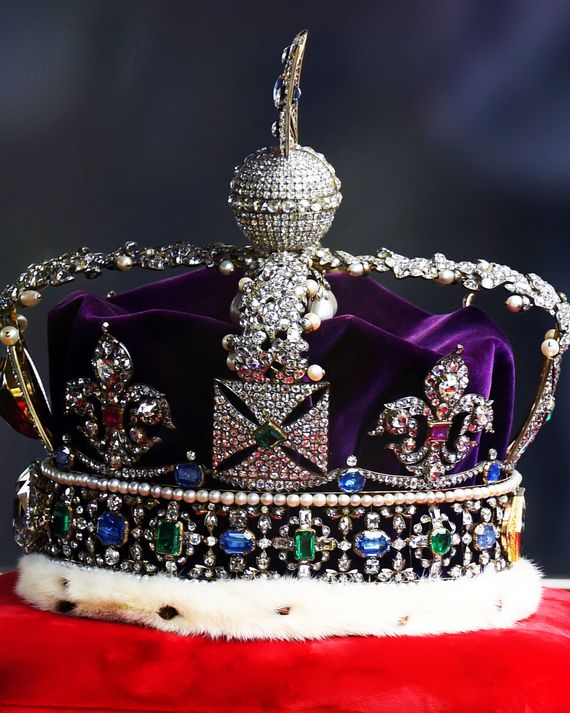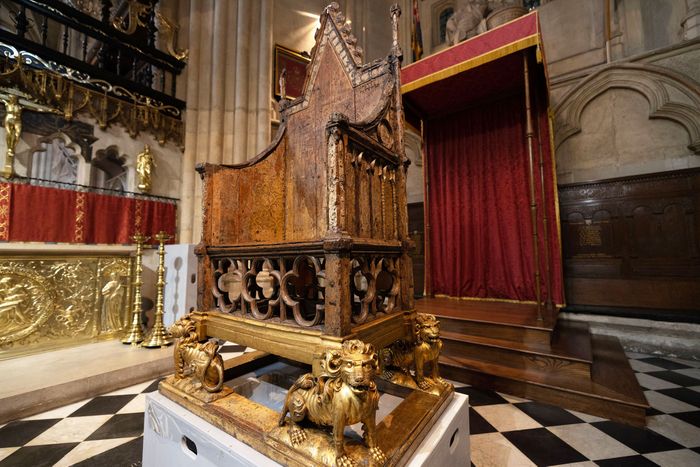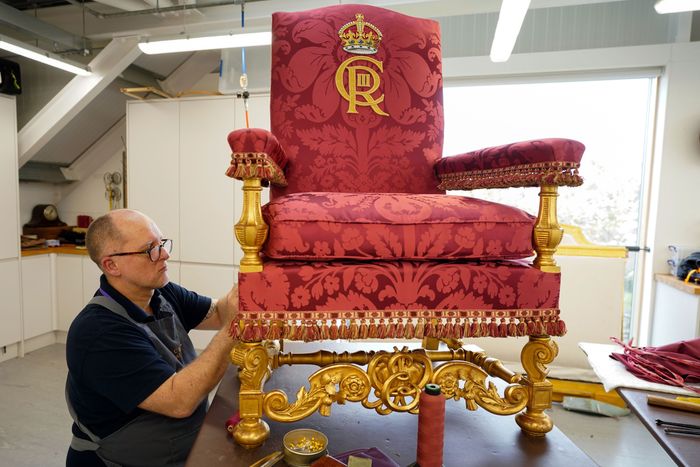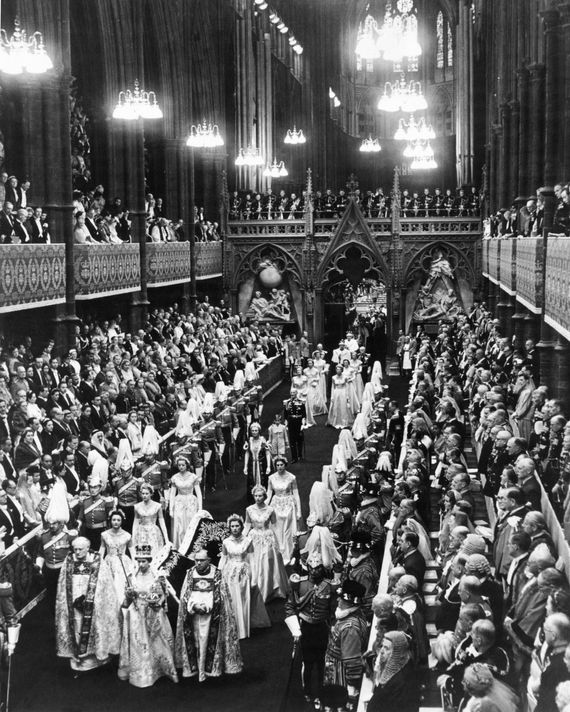
It’s been a full human lifetime since anybody has seen a new monarch of the United Kingdom installed, so it’s fair to ask what such a thing is meant to look like in 2023. Charles became king the minute his mother died, but this weekend’s coronation is the event that will cement his position in front of the world — a performance, but an important one. (Edward VIII’s infamous abdication to marry Wallis Simpson was probably simpler for the fact that he hadn’t yet been crowned.)
There’s a balance at play: The ceremony has to be lavish enough to say “monarchy,” but not so lavish as to alienate the public. It’s also a fragile time for the Windsors, and Charles is not as popular as his mother. He’ll need to look like part of a long, unbreakable human chain, and every design choice — the chairs he’ll be seated on, the jewels he’ll hold, the towering façade of Westminster Abbey itself — has a role in creating that impression. The whole thing is basically a big, delicate magic trick. And as with any illusion, props matter.
Westminster Abbey
The UNESCO World Heritage site and centuries-old Gothic masterpiece screams “stately” and “ancient” at a volume loud enough to temporarily drown out questions about whether the United Kingdom even still wants a monarch. Westminster Abbey’s history (like that of the Anglican church more broadly) is intimately bound up with that of the British monarchy; the abbey doesn’t answer to the standard church chain of command but is instead directly under the authority of the king. As an institution, it’s more than 1,000 years old — it was the last Anglo-Saxon king of England, St. Edward the Confessor, who originally offered the funds to turn a monastery already on the site into something bigger. When William the Conqueror crossed the English Channel from Normandy in 1066 and firmly settled the brutal succession scrum that followed Edward’s death, he became the first English king crowned at Westminster, setting a precedent that has been followed ever since. Rebuilt in grand Gothic style in the 13th century by Henry III in honor of Edward, Westminster Abbey is a place designed to awe. Frankly, the royals use it because it works.
The Anointing Screen
The divine right of kings has been firmly consigned to the dustbin of history, but don’t tell the Windsors that: Charles will be drizzled in holy oil specially consecrated at the Church of the Holy Sepulchre in Jerusalem in a ritual traditionally meant to confer divine authority. We won’t get to see it, though, because he’ll be completely concealed behind a screen, a piece of textile art made specifically for the coronation.
There is a very long association between royalty and sumptuous textiles; before the rise of mass production, items like tapestries and lavishly embroidered garments were one of the major ways that royal figures showcased their wealth and power because of the almost unfathomable amount of labor it took to produce them (and the therefore unfathomable amount of money it took to buy them). According to the Telegraph, Charles will be anointed behind a cloth depicting a tree with 56 leaves, each embroidered with the name of a Commonwealth member state, the work of the Royal School of Needlework at Hampton Court and “the Worshipful Company of Broderers, Drapers, and Weavers.” It is beautifully and laboriously made but aesthetically simple — a reflection of the fine line Charles is trying to walk right now.
Vestments
According to the palace, Charles has opted to use items from the coronations of George IV in 1821, George V in 1911, George VI in 1937, and Elizabeth II in 1953, which have elaborate names that sound like something out of a sword-and-sorcery novel: the Colobium Sindonis, the Supertunica, the Imperial Mantle, the Coronation Sword Belt, and the Coronation Glove. (They always reuse the Supertunica and the Imperial Mantle, but the palace specifically cited “sustainability” as its reason for recycling the others. How green!)
This is where they’re going full-on lavish: The Supertunica is designed to echo the sorts of ceremonial garments worn by monarchs going back to medieval Europe, evoking ancient ecclesiastical authority. But the early-19th-century Imperial Mantle, from the coronation of George IV, is actually the oldest vestment being used; it’s made of lavish cloth of gold and embroidered with the traditional symbols of England, Scotland, and Northern Ireland (respectively, the rose, the thistle, and the shamrock), tying up the component parts of the United Kingdom and draping them all over the king’s body.
The Coronation Regalia
And now we come to the symbolically heavy bling. The actual coronation involves a whole bunch of pieces from the crown jewels, known as the “coronation regalia.” The holy oil will be poured from an ampulla shaped like an eagle and a 13th-century spoon — both gold (naturally). They’ll place St. Edward’s Crown on Charles’s head, and he’ll be handed the sovereign’s scepter and orb, representing the power of the monarch. It’s all, once again, aggressively medieval. But with the exception of the coronation spoon, everything is a replica that dates from the 1661 coronation of Charles II. That’s because they had to replace everything melted down by the Puritans and Oliver Cromwell after Charles I got his head chopped off in 1649. (Personally, I would have opted for a less ominous regnant name than Charles III.)
The Coronation Chair
Even in a comparatively simple coronation — to the extent that such a thing is possible — there will be an eye-popping amount of gold, jewels, velvet, and stained glass on display. That’s why it’s fascinating that the centerpiece of all this activity, the throne itself, is almost shockingly plain. It’s wooden and carved with centuries’ worth of graffiti. In comparison to everything else around it, it looks like a country-church pew.
The throne was commissioned by Edward I in 1296 as a place to put the Stone of Scone, or the Stone of Destiny, which was traditionally used in the coronation of the kings of Scotland. The royal family and Westminster Abbey websites are vague about how Edward got his hands on the stone; the answer is the infamously brutal conquest of Scotland. (Some Scottish students stole it back in 1950, then quietly returned it; Prime Minister John Major returned it to Scotland in 1996, and it’s making a special trip back for Charles.)
The Coronation Chair is for the actual moment of coronation; as Harper’s Bazaar points out, Charles and Camilla will also sit on two other sets of chairs — the Chairs of Estate, originally made for Elizabeth’s 1953 coronation, and the Throne Chairs, originally made for the 1937 coronation of Charles’s grandparents.
The Cosmati Pavements
The anointing takes place in front of the high altar. In many previous coronations, there’s been a carpet underneath — rugs being another one of those sumptuous, unbelievably labor-intensive textiles that many dynasties around the world have used to demonstrate their power and wealth. Edward VII was anointed on a 16th-century Persian rug. For the coronation of Queen Elizabeth II in 1953, they went with an eye-watering expanse of gold carpets — which, in color photographs from the era, look more than a little like mid-century American-grandma goldenrod-yellow wall-to-wall. (You can almost smell the Virginia Slims.) Apparently, it was so thick that her heavy coronation robes got stuck.
But underneath those carpets was something even more amazing, which will be exposed for Charles’s coronation: a “Cosmati”-style mosaic floor, laid in 1268 (which is when St. Edward the Confessor’s original abbey was retooled by Henry III into the beginnings of the Gothic structure we know today). “It’s unique in Britain — there isn’t another pavement like this,” explained Vanessa Simeoni, Westminster Abbey’s head conservator, in a video interview. According to Simeoni, it was originally created by workmen who came all the way from Italy and collaborated with British carvers, using a combination of materials both local and transported all the way from Rome, including purple and green porphyry and Purbeck marble. Seven centuries’ worth of coronations have taken place on that mosaic, which was covered by carpet from the 1870s until 2010. This summer, visitors will be allowed to walk on the floor for the first time “in living memory,” Westminster Abbey has announced. They’ll be required to remove their shoes first.



